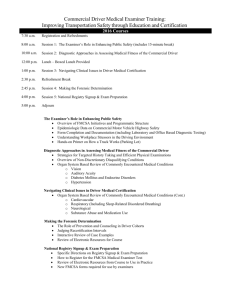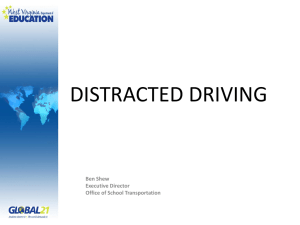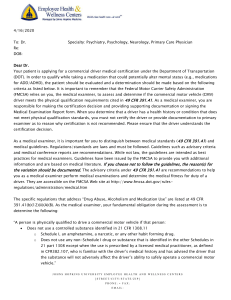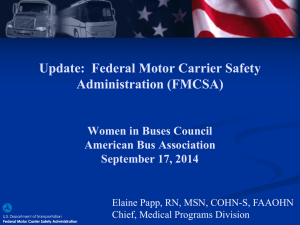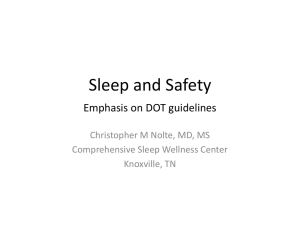Sleep Issues & CMV Drivers
advertisement
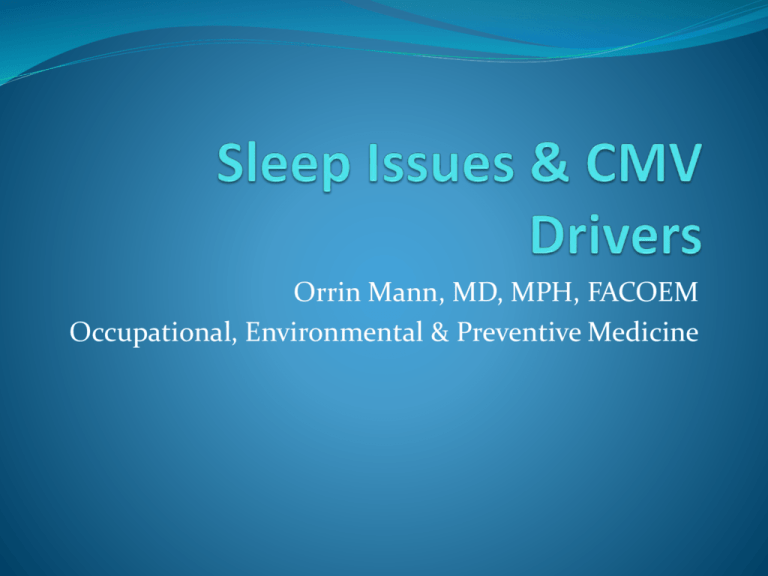
Orrin Mann, MD, MPH, FACOEM Occupational, Environmental & Preventive Medicine Minnesota Sleep Society 5th Annual Meeting Lecture Overview Case studies Impact of Sleepy CMV drivers Why the conundrum A driver’s job Review the “Rules” Describe the regulatory issues and process Review the guidance available Quick summary: There is no “Rule” for OSA. Case 1 51yo male ESS=3, BMI 37, Neck Circumference 19” Remainder of H & P normal PSG ordered, 3 month DOT card signed Employer upset and threatens to pull business Case 2 51yo male ESS=3, BMI 37, Neck Circumference 19” Remainder of H & P normal PSG NOT ordered, 2 year DOT card signed Employer’s MD audits and insists on a 3 month card and a PSG, citing the Joint Task Force recommendations. Case 3 63 yo male CMV driver Off work after MVA: took 3 pills, he believes they were Ambien and not HCTZ, “by mistake”, fell asleep, head on collision, with severe injuries to other driver. Seen elsewhere and given a DOT card. Employer requests I repeat evaluation knowing above information Case 3 Continued Drug test + for Ambien, per employer H & P otherwise normal I initially cleared driver, but later changed my mind, rescinding the card until evaluated by a sleep expert, per Joint Task Force. Employer upset, disagrees with recommendation, and doesn’t want to put driver through the “added expense.” My role today I am not a sleep expert: You guys are. I will not debate or defend any recommendations I will not discuss merits of Home vs. Lab PSG, MWT, MSLT, etc. I hope to clarify some of the regulatory, legal, bureaucratic, occupational, & financial issues Tracy Morgan Critically Hurt in New Jersey MVA 6/7/14: Wall mart sued June 2009: Miami,Oklahoma 76 year old driver falls asleep after 11 hours of driving Hits a line of Stationary cars 10 dead Sleepy Drivers Drowsy driving is a leading cause of crashes and highway fatalities, according to federal officials. More than 30,000 people die on highways annually in the United States; crashes involving large trucks are responsible for one in seven of those deaths. The DOT believes that fatigue-related causes accounted for 13 percent of all trucking accidents. 2002 NHTSA study Economic Impact of Sleepy Drivers 6 million crashes annually resulting in an economic impact of over $230 billion. >17% ($39 billion) of these costs are probably attributed to sleepiness and even this estimate may be relatively low. Blincoe LJ, Seay A, Zaloshnja E, Miller TR, Romano E, Luchter S, et al. The economic impact of motor vehicle crashes, 2000. Washington, DC: National Highway Traffic Safety Administration; 2002. Sleepy Drivers Federal rules 2013 reduced the maximum workweek for truckers to 70 hours, from 82 hours. Drivers who hit this limit can start their workweek only after a mandatory 34-hour resting period. “Restart” must include two periods between 1 a.m. and 5 a.m., to allow drivers to rest at least two nights a week. Drivers cannot drive for more than 11 hours a day and must have a 30-minute break in their schedule. (FMCSA not enforcing for short haul) Sleepy Drivers DOT based its new rules on the 2006 Large-Truck Crash Causation Study: fatigue-related causes accounted for 13 percent of all trucking accidents. Federal officials caution that fatigue was often underreported in crash investigations because truck drivers do not want to acknowledge being sleepy, lest they be seen as at fault. Often difficult to find evidence that fatigue directly caused an accident. Sleepy Drivers 1990 National Transportation Safety Board study of 182 heavy-truck accidents in which the truck driver died Concluded fatigue played a role in 31 percent of the cases: more than alcohol or drugs. Extent of problem is a matter of debate, because it is difficult to obtain evidence that the dead driver fell asleep first. Sleepy Drivers: MEP Report 2008 CMV drivers with OSA are at an increased risk for a crash when compared to their counterparts who do not have the disorder (Strength of Evidence: Minimal Acceptable). Crash risk for CMV driver: 0.08 MVA/person-year Crash risk (expected) CMV driver with OSA: 0.10-0.46 MVA/person-year or as much as 5+ times higher Non-CMV drivers with OSA are at an increased risk for a motor vehicle crash when compared with comparable drivers who do not have the disorder (Strength of Evidence: Strong). In the event of a crash with injury or death, the medical exam will be among the first things scrutinized Why the Conundrum???? Cost: PSG, CPAP, Lost income Anxiety: Financial, career Confusion Mixed messages from DOT Legal impediments to regulatory guidance Rules, regulations, guidance, panels, boards: Huh??? Multiple contradictory recommendations Trucking industry inconsistency Medical field inconsistency The Job of a Commercial Driver Driver’s duty may include: Coupling and uncoupling trailer(s) from tractors Loading and unloading Inspecting vehicle and trailer Lifting, installing and removing chains, tarps Agility, bend, stoop, crouching, climbing DOT instructs that all CMV drivers with a medical certificate must be able to do all of these, not merely their own job! The Job of a Commercial Driver Duties may included: Abrupt schedule changes Rotating work schedules Irregular sleep conditions Could impact CPAP compliance, and sleep quality Beginning a trip in a fatigued condition Long hours Extended time away from family and friends 49 CFR 391.41 Physical Qualifications for Driver A driver must have The perceptual skills to monitor a sometimes complex driving situation The judgment skills to make quick decisions The manipulative skills to control an oversize steering wheel, shift gears using a manual transmission, and maneuver a vehicle in crowded areas. Purpose of Interstate Commercial Driver Physical Examination FMCSA describes the periodic physical qualification examination of the interstate CMV driver to be a "medical fitness for duty" examination. The purpose of the physical examination is to detect the presence of any physical, mental, or organic conditions of such character and extent as to affect the ability of the driver to operate a CMV safely. The DOT Exam First DOT exams required January 1, 1954 Standard last revised (49CFR 391.41) 1970 Only MDs could perform exam till 1992. After 1992: added doctors of osteopathy, physician assistants, advanced practice nurses, and doctors of chiropractic, licensed to perform medical examinations in their state. 1999: FMCSA Federal Motor Carrier Safety Administration (FMCSA) established. One branch of the Department of Transportation (DOT). One goal: ensuring safety in motor carrier operations through strong enforcement of safety regulations FMCSA Office of Medical Programs "The mission of the Office of Medical Programs is to promote the safety of America's roadways through the promulgation and implementation of medical regulations, guidelines and policies that ensure commercial motor vehicle drivers engaged in interstate commerce are physically qualified to do so." Develops and implements medical regulations, policies, and procedures The DOT Exam 13 standards for medical fitness 4 “non-discretionary” disqualifying standards: Seizures, insulin, vision, hearing “Regulations are law and must be followed” 9 “discretionary standard” Examiner determines whether to sign the medical certificate These are neither regulations nor laws. Discretionary standards The Federal Motor Carrier Safety Administration (FMCSA) provides medical Guidelines or advisory criteria based on expert review, and considered best practice. Published in the Medical Examiners Handbook: http://nrcme.fmcsa.dot.gov/documents/FMCSAMedic alExaminerHandbook-2014MAR18.pdf Discretionary standards “The examiner may or may not choose to use these recommended guidelines. When the certification decision does not conform to the recommendations, the reason(s) for not following the medical guidelines should be included in the documentation.” Legal ramifications of diverging from Guidelines. Discretionary standards Where “Big G” guidance is unavailable, can use “little g” sources such as MEP or MRB recommendations, Motor Carrier Safety Advisory Committee recommendations, medical literature, consultants recommendations, or community best practices. Spring 2014: FMCSA removed all “Chronic Sleep Disorders”, “Sleep Disorder Test” Guidelines, and FAQ’s on OSA and EDS from the Handbook. FAQ remains on Narcolepsy: Disqualifying. Discretionary standards 391.41(b)(5): “Has no established medical history or clinical diagnosis of a respiratory dysfunction likely to interfere with his ability to control and drive a commercial motor vehicle (CMV) safely.” 391.41(b)(9): “Has no mental, nervous, organic, or functional disease or psychiatric disorder likely to interfere with his ability to drive a CMV.” DOT History Yes or No: “Sleep disorders, pauses in breathing while asleep, daytime sleepiness, loud snoring.” Questions on Hypertension, Diabetes and medications for these conditions. May add Epworth Sleepiness Scale, similar tools, or other questionnaires. Epworth in the setting of the DOT exam is unreliable in my experience. Drivers are either unaware of, under report, or underestimate EDS. DOT Physical Examination Height and Weight: required. BMI , Neck circumference: NOT required. Yes or No: “Abnormal chest wall expansion, abnormal respiratory rate, abnormal breath sounds including wheezes or alveolar rales, impaired respiratory function, cyanosis. Abnormal findings on physical exam may require further testing such as pulmonary tests and/or xray of chest.” Exam of limited utility for sleep disorders Instructions to the Medical Examiner (On the DOT exam form) “There are many conditions that interfere with oxygen exchange and may result in incapacitation, including…sleep apnea. If the medical examiner detects a respiratory dysfunction, that in any way is likely to interfere with the driver’s ability to safely control and drive a commercial motor vehicle, the driver must be referred to a specialist for further evaluation and therapy.” 1999: SAFTELU Safe, Accountable, Flexible and Efficient Transportation Equity Act: A Legacy for Users. Required Certified Driver Medical Examiners (CDME), registered on National Registry of Cerified Medical Examiners (NRCME). Effective May 21,2014. Before: 900,000 examiners. Now: 40,000 CDMEs. SAFTELU Exam results are submitted to a national database. In 3 years FMCSA will forward the medical certification status to the states for inclusion in the Commercial Driver Licensing Information System (CDLIS). Drivers with Canadian or Mexican CDLs who are operating in the United States under NAFTA agreements are not required to be examined by examiners on the NRCME. FAQ: “What happens if a driver is not truthful about his/her history on the medical examination form?” Driver is required to complete the Health History section and certify that the responses are complete and true. Must certify that he/she understands that inaccurate, false or misleading information may invalidate the examination and medical examiner’s certificate issued based on it. A civil penalty may also be levied against the driver under 49 U.S.C. 521(b)(2)(b), either for making a false statement or for concealing a disqualifying condition. FMCSA Standard and Guideline Review Based on agency experts’ analysis of international, national and state data Interagency national and international regulatory analysis Evidence reports, written by FMCSA based on above items Medical Expert Panels (MEP) Medical Review Board (MRB) Motor Carrier Safety Advisory Committee (MCSAC) MEP MEDICAL EXPERT PANEL “Each MEP is comprised of an independent panel of physicians, clinicians, and scientists who are experts in their specialty fields.” An MEP is periodically commissioned by FMCSA for specific medical topics. MEP reviews the evidence in the about a question or topic, and makes recommendations to the Agency in the form of a report. This report is an “opinion for consideration” for FMCSA. http://www.fmcsa.dot.gov/rulesregulations/topics/mep/mep-reports.htm Once approved, it become a Guidline. MRB MEDICAL REVIEW BOARD “The MRB is composed of five of our Nation's most distinguished and scholarly practicing physicians. These physicians were chosen from a field of many qualified candidates who possess a wide variety of expertise and experience. MRB members specialize in the areas most relevant to the bus and truck driver population.” MCSAC- Chartered 2006 MOTOR CARRIER SAFETY ADVISORY COMMITTEE “Is comprised of 20 experts from the motor carrier safety advocacy, safety enforcement, industry, and labor sectors.” Not medical professionals Provide advice and recommendations to the FMCSA Administrator on motor carrier safety programs and motor carrier safety regulations. See link for current members: http://mcsac.fmcsa.dot.gov/members.htm FMCSA Standard and Guideline Review MRB: Meets 3-4 x per year Review Evidence Reports and MEP opinions, if an MEP has been convened Proposes recommendations to FMCSA FMCSA reviews all of this, and considers feasibility and impact. Posts proposed changes to current standards for comment Medical Examiners Handbook updated with new Standards or Guidelines •May 2010: The American Sleep Apnea Association, the American Trucking Associations and the FMCSA co-sponsored a national Sleep Apnea & Trucking Conference about sleep apnea’s effect on truckers. •April 20, 2012: FMCSA published a Proposed Regulatory Guidance for obstructive sleep apnea (OSA) and request for comment. •April 27, 2012: FMCSA published a withdrawal notice on its Proposed Recommendations on Obstructive Sleep Apnea. H.R.3095, enacted Oct 15, 2013 To ensure that any new or revised requirement providing for the screening, testing, or treatment of individuals operating commercial motor vehicles for sleep disorders is adopted pursuant to a rulemaking proceeding, and for other purposes. Does not prohibit enacting Guidelines (e.g. in the Handbook), but FMCSA intends to only propose new Guidelines through the notice and comment process. Net effect: Everything is delayed. FMCSA Standard and Guideline Currently nothing on sleep disorders is available in the Medical Examiners Handbook, and prior Guidelines have been vacated. Current FAQ: Narcolepsy “The guidelines recommend disqualifying a CMV driver with a diagnosis of Narcolepsy, regardless of treatment, because of the likelihood of excessive daytime somnolence.” Trucking Industry Opposes Rule changes On 6/6/14 Senator Susan Collins, pushed an amendment through the Senate Appropriations Committee that would freeze the rules, stating the administration had failed to take into account that the new rules would put more trucks on the roads during peak traffic hours, and safety studies are needed. Trucking officials and executives also said that drivers needed to be afforded maximum flexibility in their work and should not be told when to rest. Industry claim: rules reduce productivity. Assessing Risk Does the Driver Pose a Risk to Public Safety? “As a medical examiner, any time you answer “yes“ to this question, you should not certify the driver as medically fit for duty.” A balance between the “right” or desire to work and public safety Assessing Risk Physical Conditions: Symptoms: Does the condition interfere with the ability to drive? Does the condition cause incapacitation? Sudden: Can driver safely stop vehicle before incapacitation or LOC? Gradual: Is the driver unaware of diminished capacity, adversely affecting safety? Assessing Risk Mental conditions Cognitive: Can the driver process environmental cues rapidly and make appropriate responses, independently solve problems, and function in a dynamic environment? Behavioral: Are the driver reactions appropriate, responsible, and nonviolent? Assessing Risk Medical treatment: Effects: Does treatment allow the driver to perform tasks safer than without treatment? Side effects: Do side effects interfere with safe driving (e.g., drowsiness, dizziness, orthostatic hypotension, blurred vision, changes in mental status)? Acceptable Risk From Cardiovascular Advisory Panel (MEP) Acceptable Risk is a medical and societal issue “Given the complex demands of operating a large truck or bus, coupled with the high fatality risk for occupants of the other vehicle in crashes involving CMV’s, a conservative approach is required.” 1% annual risk of sudden incapacitation (impairment) is often used. VACATED Former FMCSA GUIDELINES Chronic Sleep Disorders Waiting period Minimum – 1 month after starting CPAP Minimum – 3 months symptom free after surgical treatment Maximum certification – 1 year Recommend to certify if the driver has: Successful nonsurgical therapy with Multiple Sleep Latency Test WNL Resolution of OSA confirmed by repeat sleep study during treatment Continuous successful non surgical therapy for 1 month Compliance with continuing nonsurgical therapy Resolution of symptoms following completion of post- surgical waiting period VACATED Former FMCSA GUIDELINES Chronic Sleep Disorders Recommend not to certify if the driver has: Hypoxemia at rest Diagnosis of: Untreated symptomatic OSA Narcolepsy Primary (idiopathic) alveolar hypoventillation syndrome Idiopathic CNS hypersonmolence RLS with EDS The driver who is being treated for OSA should remain symptom free and agree to: Continue uninterrupted therapy Undergo yearly objective testing (e.g. MSLT or MWT) VACATED Former FMCSA GUIDELINES Sleep Disorder Tests PSG “in a controlled sleep laboratory” Severity (AHI) Mild : 5+ episodes/hour Moderate : 15+ episodes/hour Severe : 30+ episodes/hour Apnea/hypopnea >30 episodes/hr of sleep is considered a diagnosis of OSA Self-reported Sleepiness Surveys: NOTE: Self-reported sleepiness does NOT always correlate with objective testing (PSG). The driver may not perceive sleepiness as excessive or may be hesitant to disclose sleepiness. OSA: Unofficial Guidance 2006 Joint Task Force ACOEM, NSF, ACCP 2008 Medical Expert Panel FMCSA Medical Review Board 2012 Motor Carrier Safety Advisory Committee/Medical Review Board FMCSA has not chosen which guidelines to follow, but says that the only incorrect action is to do nothing. OSA: Unofficial Guidance (MEP, JTF, MRB/MCSAC) All address (with some differences) Criteria for OSA screening (BMI, neck circumference, medical DX, symptoms, etc.) Disqualifying vs. In-service (conditional) criteria Waiting period Diagnostic screening Treatment Monitoring All agree to one year certification with OSA Members of MEP Sonia Ancoli-Israel, PhD :Professor of Psychiatry at the University of California San Diego School of Medicine, Director of the Sleep Disorders Clinicat the Veterans Affairs San Diego Healthcare System, Co-Director of the Laboratory for Sleep and Chronobiology at the UCSD GCRC, and Co-Director of the Education and Dissemination Unit of the VA VISN-22 Mental Illness Research, Education and Clinical Center (MIRECC). Charles Czeisler, PhD MD Baldino Professor of Sleep Medicine, Harvard Medical School and Senior Physician for the Division of Sleep Medicine at Brigham and Women's Hospital. Charles George, MD FRCPC Professor of Medicine at the University of Western Ontario in London, Canada and Director of the LHSC Sleep Disorders Laboratory. Christian Guilleminault, MD BiolD Professor of Psychiatry and Behavioral Sciences at the Stanford School of Medicine. Allan Pack, MB, ChB, PhD Professor of Medicine, and Neurology at the University of Pennsylvania School of Medicine and chief of the Division of Sleep Medicine and director of the Centerfor Sleep and Respiratory Neurobiology MEP 2008 Studies in passenger car drivers all show there is an increased risk of crashes in individuals with an AHI>30 Some studies show that there is an increased risk in individuals who have less severe sleep apnea. Studies comparing individuals with excessive sleepiness to those who do not have sleepiness find that having an AHI≥20 episodes/hour is a risk factor for excessive sleepiness. (Pack, A.I., et al.,(2006). Risk factors for excessive sleepiness in older adults. Ann. Neurol. 59:898-904.) The expert panel thus believed that individuals with an AHI <20 who were not excessively sleepy could be certified to drive. MEP: Certify annually if Has untreated OSA with an AHI </= 20 AND Has no daytime sleepiness, OR Has OSA that is being effectively treated MEP: Conditional Certification BMI >/=33: one month certification pending sleep study (Panel wanted to make this a one week certification, but not practical due to lack of access to PSG.) Note: contradict themselves. See next slide Recently diagnosed OSA Certify for 1 month while starting CPAP After 1 month, certify x 3 months Reassess compliance after 3 months, and if good, certify for 1 year MEP: Do NOT certify Report of excessive sleepiness while driving, OR Experience a crash associated with falling asleep, OR AHI > 20, until compliant with CPAP Have undergone surgery, < 3 months post-op, OR Individuals non-compliant with treatment at any point, OR BMI >33, pending sleep study Joint Task Force (JTF): 2008 Made up members of American College of Chest Physicians American College of Occupational and Environmental Medicine National Sleep Foundation Joint Task Force Disqualify Observed/confessed excessive sleepiness MVA related to sleep unless evaluated since ESS>/=16 or FOSQ<18 Diagnosed OSA Noncompliant or no follow-up Surgical Tx w/o objective follow-up testing AHI>30 Joint Task Force In-service Qualification (3 months) if any one of the following 5 categories: History suggestive of OSA 2 or more: BMI>35; BP new/uncontrolled/2+ medications; neck circumference >16”Women or >17”men ESS>10 Unconfirmed treatment compliance Prior PSG with AHI 6-29, AND: no MVA, No EDS, and <2 BP meds. MRB/MCSAC Recommendations: OSA Diagnosis of OSA precludes 2 yr certification May certify a driver with OSA if: AHI </= 20 (i.e. mild-moderate OSA) and The driver does not admit to experiencing excess sleepiness during the major wake period, or The driver’s OSA is being effectively treated. May certify a driver with OSA annually based on demonstrated compliance with treatment. Minimally acceptable compliance with PAP is 4 hours/day, 70% of days. 4 MRB/MCSAC Recommendations: OSA Disqualify immediately or fail to certify if any of the following: The driver admits to experience excessive sleepiness during the major wake period while driving, or The driver experienced a crash associated with falling asleep, or The driver has been found non-compliant with treatment, as defined above. MCSAC/MRB The MCSAC members are not medical professionals The MRB members are not experts in sleep disorders For these reasons, I treat MCSAC/MRB guidance with the least weight of all the recommendations. Competing Guidelines Summary Waiting Period after treatment started ME Handbook (Vacated Big G)– requires 1 month compliance after diagnosis to return to driving Joint Task Force (little g)– requires 2-4 weeks compliance for those with AHI >30, and no wait for those with AHI 5-30 MCSAC/MRB (below little g) – requires 1 week compliance for those initially disqualified, and no wait for those who conditionally qualified MEP- no waiting period, but they suggest <2weeks of treatment needed to be effective Antihistamines Recommend to certify if: As the medical examiner, you believe that the treatment does not endanger the health and safety of the driver and the public. Recommend not to certify if: Treatment interferes with driving ability “The driver should abstain from medication for 12 hours prior to operating a vehicle.” Sleeping Pills First generation antidepressants: FMCSA recommends NOT to certify Trazadone: not discussed Sedating Anxiolytics: recommend not to certify Hypnotic: May certify Hypnotic, if the medication is: Short-acting (half life of less than 5 hours). The lowest effective dose. Used for a short period of time (less than 2 weeks) Sedating Medications Drug Onset Peak Half Life Duration Alprazolam 1 Hour N/A 11 Hours 5 Hours Amitriptyline N/A 4 Hours 15 Hours N/A Benadryl 1-2 Hours N/A 2/5-9 Hours N/A Eszopiclone 30 Minutes N/A 6 Hours 8 Hours Gabapentin N/A 2-4 Hours 5-7 Hours N/A Lorazepam 20-30 Minutes N/A 18 Hours N/A Mirtazepine N/A 2 Hours 20-40 Hours N/A Nortriptyline N/A 7-8 Hours 28-31 Hours N/a Pregabalin N/A 1/5 Hours 6.3 Hours N/A Ramelteon 30 Minutes N/A 1-2.6 Hours 8 Hours Temazepam 1-2 Hours N/A 3.5-18 Hours 6-10 Hours Trazedone N/A 30-100 Min. 7-10 Hours N/A Triazolam 15-30 Minutes N/A 1.5-5.5 Hours 2-5 Hours Zaleplon N/A 1 Hour 1 Hour 4 Hours Zolpidem 30 Minutes 1.5 Hours 2.5 hours 6-8 Hours Zolpidem CR 30 Minutes 1.6 Hours 2.8 Hours 8 Hours Summary Sleepy CMV drivers are deemed an unacceptable risk FMCSA has vacated all previous OSA Guidelines Legislation has delayed the issuance of new Guidelines FMCSA has said that the only incorrect action is to do nothing Multiple competing recommendations exist. Sedating medications should not be used by CMV drivers. Any Questions?
